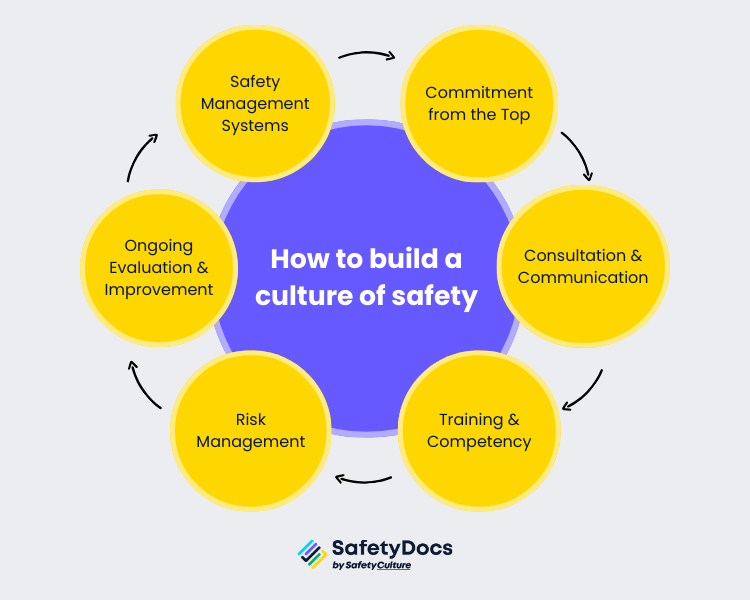The concept of safety is often confined to meeting regulatory standards. While safety compliance with regulations is crucial, it represents only the baseline. Workplace safety isn’t just about ticking boxes on a checklist.
Safety compliance alone can sometimes lead to a “checklist mentality,” where the goal is simply to avoid penalties rather than genuinely promoting safety. The true goal should be to foster a culture of safety. In contrast, a poor safety culture can lead to operational errors, miscommunication, and inadequate safety measures, ultimately resulting in catastrophic accidents. But how do we go beyond mere compliance?
Limitations of Compliance-Only Mindset
Reactive vs. Proactive Approach
Compliance-only approaches tend to be reactive, addressing risks and concerns only when they become apparent or after incidents occur. On the other hand, a proactive approach focuses on identifying and addressing potential hazards before injury or harm occurs.
A key aspect of this proactive approach is the identification and investigation of unsafe acts, ensuring a fair and consistent process that differentiates between errors and violations.
Minimal Effort
When focusing on meeting minimum legal requirements, companies may do just enough to comply rather than strive for their group values of excellence in safety practices. This may result in a false sense of security and insufficient safety precautions.
Neglecting Human Factors
Compliance with laws doesn't always account for human safety factors. For example, according to regulations, a machine might not be classified as hazardous. However, accidents can still occur if the equipment is operated unsafely or without proper training.

Why "Beyond Safety Compliance" Matters
Reduced Incident Rates
A proactive safety culture encourages employees to identify and address hazards before they lead to incidents, decreasing the chances of accidents and injuries.
- Hazard Identification: Employees are trained and motivated to spot potential environmental risks.
- Mitigation Strategies: With a proactive approach, measures are taken to eliminate or control hazards, preventing incidents before they occur. Focus groups are also used to measure and assess safety culture.
Improved Morale & Retention
When employees perceive their safety, health and well-being as top priorities, they are more likely to feel valued and secure in their positions.
- Greater Loyalty: A safe working environment fosters trust and respect, enhancing loyalty and reducing turnover.
- Job Satisfaction: Employees who feel safe are more satisfied with their jobs, contributing to a positive workplace atmosphere.
Enhanced Productivity
A strong safety culture minimises accidents and the disruptions they cause, leading to a more efficient work environment.
- Efficient Work Environment: With fewer accidents, there is less downtime and fewer operational delays.
- Increased Focus: Employees can focus on tasks without distraction or concern about potential hazards.
Reputation & Brand
Companies with robust safety records are perceived as socially responsible, enhancing their reputation among customers, investors, and the broader community.
- Attracting Talent: A solid commitment to safety can attract top talent who prioritise working for responsible and caring employers.
- Customer Trust: Customers trust and prefer companies that prioritise employee well-being.
Choosing a "Beyond Compliance" approach over a mere "compliance-only mindset" means integrating safety as a core value. The goal is to foster a culture of safety woven into every action and decision.

What is a Culture of Safety?
A workplace culture of safety refers to an environment where safety is a core value integrated into every aspect of the organisation. While there's no universally accepted definition of safety culture, its essence lies in the collaborative efforts of individuals to ensure workplace safety. Ultimately, every interpretation centres around people.
Foundation of a Culture of Safety
While every organisation is unique, some key elements are common to most successful safety cultures.
Strong Leadership Buy-In
Leaders set the tone for a safety culture. Their commitment is crucial for fostering an environment where safety is prioritised. A company's leadership must go beyond just delegating safety responsibilities; they must be visible safety champions.
Open Communication
Workers must feel comfortable reporting hazards, near-misses, and suggestions for improvements without fear of reprimand. Potential risks may go unnoticed without open communication, and safety incidents can occur.
Positive Reinforcement
Focusing on acknowledging and rewarding safe behaviours rather than punishing errors promotes a more proactive attitude towards safety issues. This approach creates a positive culture where people feel valued and motivated to maintain safe practices.
Shared Responsibility
Safety is everyone's responsibility, from the shop floor to the executive suite. Creating a culture of shared responsibility means involving all employees in safety initiatives and making them accountable for their actions.
Proactive Risk Management
Risk management is an ongoing process in a safety culture. Regular risk assessments and proactive measures to eliminate or mitigate potential hazards are critical for all operations and creating a safe work environment.

How to Build a Culture of Safety
Establishing a safety culture at work involves a strategic approach that starts with leadership and reaches every level of the organisation. Here are steps to help you establish and nurture this culture:
Commitment from the Top
Leaders need to authentically demonstrate their dedication to safety. This includes making safety a core value of the organisation and leading by example.
When leaders prioritise work health and safety (WHS), employees are more inclined to do the same. SafeWork Australia has developed five leadership principles to integrate WHS values into your workplace culture:
- Commitment to safety
- Be involved
- Promote participation
- Integrate WHS part of your business
- Evaluate performance.
Consultation and Communication
As stated earlier, open communication is crucial for creating a culture of safety. Consultation encourages worker involvement in identifying hazards, implementing solutions and continuous improvement. Consultation also is a legal requirement under WHS regulations.
The person conducting a business or undertaking (PCBU) must consult about WHS matters with:
- employees and individuals impacted by a work health and safety issue
- health and safety representatives (HSRs)
- other PCBUs or duty holders
Training and Competency
To develop and maintain a safe workplace, employees must be equipped with the necessary knowledge, skills and experience. Employers should provide regular training on safe work practices, hazard identification, emergency procedures, etc.
Additionally, establishing competency requirements for each role ensures that workers are adequately trained to carry out their responsibilities safely. Education and training are crucial in establishing a food safety culture, addressing the challenges of a diverse workforce, and ensuring compliance with safety practices.
Risk Management
A culture of safety requires proactive risk management. This involves identifying hazards, assessing risks, and implementing control measures to eliminate or minimise potential harm.
Regularly reviewing procedures and actively seeking employee feedback can aid in pinpointing areas for enhancement to improve safety and ensuring ongoing risk management.
Ongoing Evaluation and Improvement
Building a safe workplace requires continuous effort and dedication. Regular evaluation of strategies, policies, and procedures is vital for identifying areas for improvement and continuously strengthening the safety culture.
Review and update safety programs and policies regularly based on feedback, incident reports, and new industry standards. Embrace continuous learning and improvement to keep the safety culture dynamic and effective.
Safety Management Systems
Implementing a safety management system (SMS) can help manage and maintain a culture of safety. An SMS is a structured framework designed to manage organisational safety risks. It integrates safety into the operational processes, ensuring safety considerations are systematically addressed throughout the organisation.
Here’s an in-depth look at the key components and benefits of SMS:
Components of Safety Management Systems
Safety Policy
This component outlines the organisation's commitment to safety and sets specific safety goals. It defines the practices, methods, processes, and organisational structures necessary to achieve these goals.
Safety Risk Management
This component entails:
- Identifying potential and existing hazards
- Assessing and analysing risks
- Implementing methods to control those risks
Steps include system description, hazard identification, risk analysis, risk assessment, and risk control.
Safety Assurance
This component ensures the effectiveness of risk control strategies and identifies new potential hazards. It involves:
- Monitoring risk controls during operations
- Conducting internal audits
- Performing investigations
- Utilising employee reporting systems
Safety Promotion
This component aims to foster a positive safety culture through training, communication, and advocacy for a safer workplace.
SafetyDocs: Building a Culture of Safety
Documentation for systems, reporting, safety culture assessment, and training is critical to creating a safety-first mindset. SafetyDocs by SafetyCulture offers a comprehensive library of customisable templates for management systems, ensuring your organisation has the necessary documents to build and maintain a strong safety culture.
Take the first step by checking out these documents:
- Occupational Health & Safety Policy
- Occupational Health, Safety & Environmental (OHSE/WHSE) Management System
- Risk Management Plans
Establishing a safety culture is a continual journey, not a final destination. It requires continuous effort and unwavering commitment. Start building your safety-first culture today with SafetyDocs. Contact us for more information or to get started.
Our team of experts is dedicated to providing accurate and informative content. Craig Cruickshank, our senior HSEQ advisor at SafetyDocs by SafetyCulture has reviewed this blog post to ensure the highest level of quality.
Learn more about Craig's work on LinkedIn for more industry insights.
Available for instant download and supplied in fully editable MS Word format for use in your business.
Please note that the above information is provided as a comment only and should not be relied on as professional, legal or financial advice.
Share This Article
